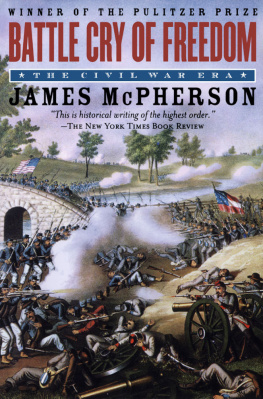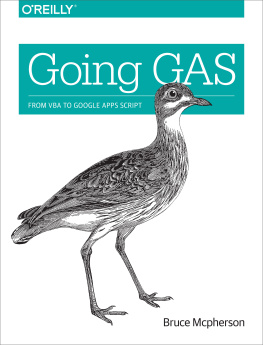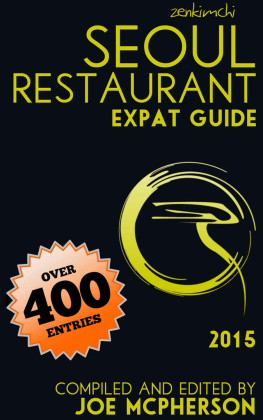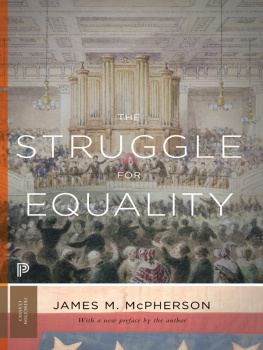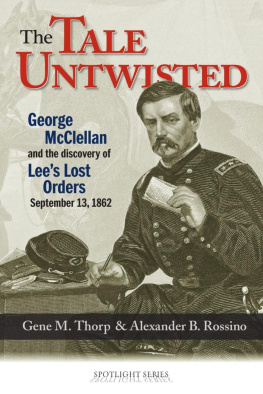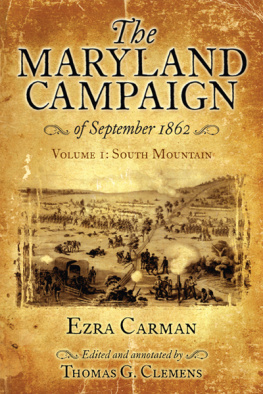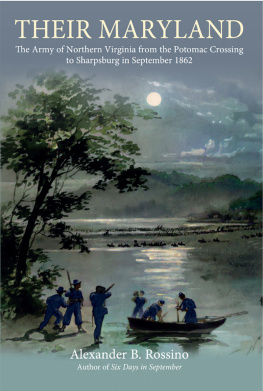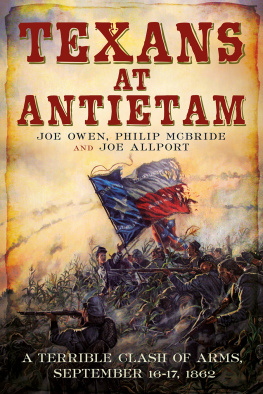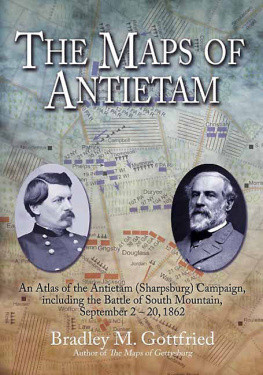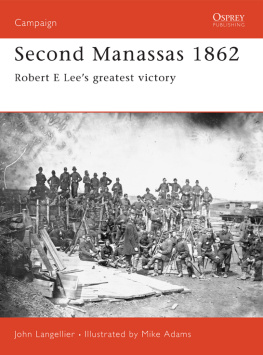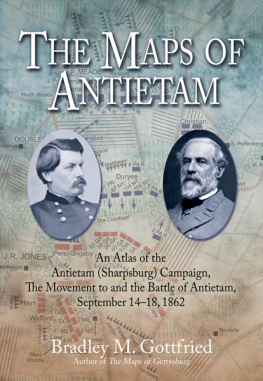ALSO BY JAMES M. MCPHERSON
The Struggle for Equality:
Abolitionists and the Negro in the Civil War and Reconstruction
The Negros Civil War: How American Negroes
Felt and Acted During the War for the Union
Marching Toward Freedom: The Negro in the Civil War
The Abolitionist Legacy: From Reconstruction to the NAACP
Ordeal by Fire: The Civil War and Reconstruction
Battle Cry of Freedom: The Civil War Era
Abraham Lincoln and the Second American Revolution
What They Fought For, 18611865
Drawn with the Sword: Reflections on the American Civil War
For Cause and Comrades: Why Men Fought in the Civil War
Lamson of the Gettysburg: The Civil War Letters
of Lieutenant Roswell H. Lamson, U.S. Navy

PIVOTAL MOMENTS
IN AMERICAN HISTORY
Series Editors
David Hackett Fischer
James M. McPherson
James T. Patterson
Brown v. Board of Education:
A Civil Rights Milestone and Its Troubled Legacy
Maury Klein
Rainbows End:
The Crash of 1929
CROSSROADS OF FREEDOM
Antietam
James M. McPherson

CROSSROADS OF FREEDOM

Oxford New York
Auckland Bangkok Buenos Aires Cape Town Chennai
Dar es Salaam Delhi Hong Kong Istanbul Karachi Kolkata
Kuala Lumpur Madrid Melbourne Mexico City Mumbai Nairobi
So Paulo Shanghai Singapore Taipei Tokyo Toronto
and an associated company in
Berlin
Copyright 2002 by James M. McPherson
Published by Oxford University Press, Inc.,
198 Madison Avenue, New York, New York 10016
www.oup.com
Oxford is a registered trademark of Oxford University Press
All rights reserved. No part of this publication
may be reproduced, stored in a retrieval system, or transmitted,
in any form or by any means, electronic, mechanical,
photocopying, recording, or otherwise, without the prior
permission of Oxford University Press.
Library of Congress Cataloging-in-Publication Data
McPherson, James M.
Crossroads of Freedom : Antietam
/ James M. McPherson
p. cm. (Pivotal moments in American history)
Includes bibliographical references (p. ) and index.
ISBN 0-19-513521-0 ISBN 0-19-515857-1 (signed ed.)
1. Antietam, Battle of, Md., 1862 I. Title. II. Series.
E474.65 .M48 2002 973.7336dc21 2002025252
1 3 5 7 9 8 6 4 2
Printed in the United States of America
on acid-free paper
To Gwynne
and to her bronze friend,
Mr. Lincoln
CONTENTS
MAPS
The KentuckyTennessee Theater, WinterSpring 1862
The Peninsula Campaign, AprilMay 1862
The Seven Days Battles, June 25July 1, 1862
Confederate Raids and Invasions in the West, SummerFall 1862
The Battle of Second Manassas (Bull Run)
Lees Invasion of Maryland, 1862
Antietam, September 17, 1862
EDITORS NOTE
This volume is part of a new series called Pivotal Moments in American History. Our purpose is to encourage interest in problems of historical contingency.
Scholars in many disciplines have been moving in this direction, and they have done so in different ways. A leading example is James McPhersons Battle Cry of Freedom, a general history of the Civil War that centers on the dimension of contingency, in the sense of turning points, when the war might have gone altogether differently. Another is Stephen Jay Goulds Wonderful Life: The Burgess Shale Fossils and the Nature of History, which constructs a new model of natural history on historical contingency as small, unpredictable events that shaped the course of evolution. A third is my book Paul Reveres Ride, which is about contingency in yet another meaning of people making choices, and choices making a difference. The logo for this series is one of the lanterns in the Old North Church.
Ideas of contingency are drawing more attention in historical scholarship, for several reasons. They offer a way forward, beyond the old political history and the new social and cultural history, by a reunion of process and event. They also restore a lost element of narrative tension to historical writing. A concept of contingency makes history more teachable and learnable, more readable and writable, more important and even urgent in our thinking about the world, and most of all more true to itself.
James McPhersons Crossroads of Freedom is a model of what might be done with this approach. The book is about the battle of Antietam (to Southerners, Sharpsburg), a great and terrible event that made September 17, 1862, the bloodiest day in American history. Much of the book is about small events such as Lees lost Special Orders No. 191, which fell into McClellans hands at an opportune moment. James McPherson speculates about that chance happening in a fresh and thoughtful way, by asking what might have happened if McClellans Special Orders had fallen into Lees hands. Counterfactual questions are heuristically useful as what the Germans call thought experiments.
But counterfactual questions and reductive explanations are not what this book is mainly about. This is a history of contingency in a larger spirit and a different key. It takes a long view of its subject and sets the battle firmly in the context of large historical processes. This is also an idea of historical change not as a single transforming event, but as a web of contingencies.
The book is also a model in another way. In a work of large purpose, where particular details make a difference, historians must get the small things right. The quality of James McPhersons scholarship is an example to us all in that respect, more so than one might realize from a quick and easy reading. Its narrative is so fluent that a reader might miss the authors unrivaled command of the subject, his mastery of the materials, his meticulous attention to matters of substance and detail, and his uncompromising integrity in a long career of research and reflection on the American Civil War.
In all of these ways, this book is a model of large importance for the study of the past and a way forward for scholarship in the future. I hope that you, the reader, will think so too.
David Hackett Fischer
PREFACE
The meaning of freedom was central to the meaning of the American Civil War. Freedom, or liberty, has been a contested issue through all of American history. We all declare for liberty, said Abraham Lincoln during the war, but in using the same word we do not all mean the same thing. Three definitions of freedom struggled for dominance from 1861 to 1865. The Confederacy, said its President Jefferson Davis, was forced to take up arms to vindicate the political rights, the freedom, equality, and State sovereignty which were the heritage purchased by the blood of our revolutionary sires. But Lincoln insisted that an independent Confederacy would destroy the nation established by those revolutionary sires as the last best hope for the preservation of republican freedom. We must settle this question now, said Lincoln a month after the outbreak of war, whether in a free government the minority have the right to break up the government whenever they choose.
Neither the Union nor Confederacy at first included the emancipation of four million slaves in its definition of the freedoms for which each side fought. Indeed, the Confederate states had seceded from the Union to escape the perceived threat posed by Lincolns election to the survival of slavery. That
Next page

